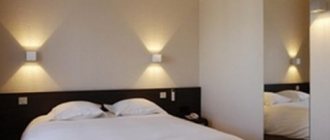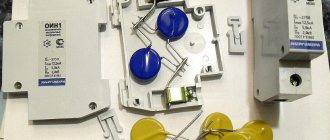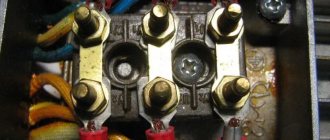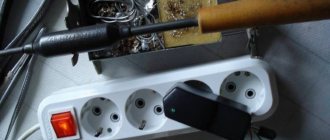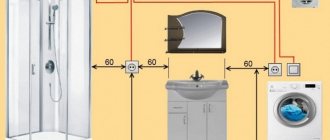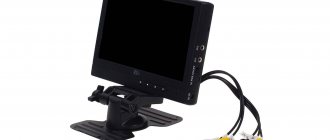What is a pass-through switch
A pass-through switch is a device designed to turn on one light source from different points in the apartment. Electricians call such a device a switch, because this largely reflects its functions. Other names are “changeover”, “crossover”, “marching” or “backup”.
The main difference is the presence of more contacts. For example, if a conventional device has two contact connections, a transitional device has three. Two of them are common, which ensures that the light bulb turns on from different places, for example, at the beginning and end of the room.
Circuits with pass-through switches of more than two
When there is a long corridor, such as in a dormitory, then using only two switches at the beginning and end is quite small, and it is advisable to place them, if not at each of the doors, then at least through a certain length of spans.
For such cases, pass-through switches have also been used, however, when the number of points is more than two, the use of so-called cross switches is mandatory, and the peculiarity of such a connection is the use of ordinary feed-through switches at the edges of the circuit, and all intermediate ones must be cross switches.
Unlike pass-through switches, a crossover switch always has an even number of inputs and outputs, and accordingly, the number of incoming and outgoing lines will always be the same.
Tips in the article “How to change a switch?” Here.
After connecting the first pass-through switch, the two-wire output line is connected to the incoming terminals of the crossover, and its output contacts are connected by wires to the input contacts of the next one. and so on until it reaches the contacts of the last switch.
Design and operating principle
Externally, the pass-through switch is no different from a regular one.
But still it has distinctive features:
- the button shows two arrows (up and down), which are located on top of each other;
- three contact groups - one input and two outputs;
- three-wire switching, providing voltage redirection between contact groups.
To control one light source, two pass-through switches are required.
The operating principle is as follows:
- a neutral and phase wire are supplied to each switching device;
- moving the key to another position causes voltage to be supplied to the light bulb;
- When either of the two switches is turned off, the power circuit is broken and the light source goes out.
Switching on and off is possible not only from two, but also from a larger number of points. To do this, you need to add one or more redundant switches.
Pass-through switches
The walk-through switches are not much different in appearance from simple switches. It has a housing, three terminals for connecting wires, 1 or 2 keys. As for the crossover switches, they have 4 terminals for connecting electrical wires. If you need to control two groups of lamps on one luminaire, use only pass-through switches with two keys.
Connecting a two-key switch to two light bulbs is not difficult. Such devices have 6 terminals for connecting wiring. As for conventional switches, they have only 3 terminals. Cross connectors have 8 terminals for connecting wires.
As for the internal design features, a circuit consisting of two lines is connected to the pass-through switch. Regardless of the position of the key, one line will always be closed and the other open. It turns out that when you connect a two-key switch to two light bulbs, the circuit that passes through it does not open. This can be seen in the diagram given in the article.
Where can I install
The changeover switch can be installed in any room. Most often it is installed in the following places:
- Landing. March switches are installed on several floors to control general lighting. For example, a resident of a house can turn on the pass-through switch at the entrance to the entrance, and when he goes up to the third floor to his apartment, turn off the light. You can proceed in a similar way when descending from top to bottom: first turn on the light bulb with a duplicate switch, and then turn it off at the bottom.
- Corridor. If there is a long corridor in an apartment or house, a pass-through switch is installed at the end and at the beginning of the room. So, when you start moving along the corridor, you can turn on the light, and when leaving it, turn it off.
- Bedroom. A convenient option is to place switches at the entrance and near the bed. In this case, you can go to bed and not get up to turn off the lights. This is especially important in a children's room so that the child does not have to walk through the entire room to turn on / off the lighting.
In practice, other methods of connecting such switches to a light bulb can be used. The main thing is to understand the principle of operation and determine the need to install the device. Most often this is done for convenience and/or energy savings.
Advantages of pass-through switches
Duplicate switches have a number of positive qualities that make them stand out among conventional devices.
Pros:
- Controlling one light source from different parts of the room.
- Safety of use.
- Easy to install and configure.
- Low cost and, as a result, low price.
- Saving electricity.
- Reliability in operation.
- Possibility of installation by yourself without the involvement of a specialist.
Flaws
Such switches also have a number of disadvantages that must be taken into account during installation.
Let's highlight the main ones:
- If you don't know the main differences, they can easily be confused with a regular switch.
- There is no precise position to detect the position (on, off). For example, when replacing a light bulb, it is difficult to understand whether the power supply to the device is suitable or not. For safety, it is recommended to turn off the power supply.
- There are many wires appearing in the junction box. Their number increases with the number of light bulbs. It is not advisable to connect devices directly, because in this case you will have to endure high costs. In addition, with a large number of lamps in one circuit, the use of pulse relays is provided.
- Higher price due to design features.
Step-by-step installation instructions
Theoretically, the process of connecting a switching device can be divided into several main stages. Installation must begin with the cables. So, if the wiring is old enough, then it must be replaced with a new one. After this, you need to make the correct connection of the wires in the junction box, and then in the switch itself. To install a lamp or chandelier, you must use the manufacturer's instructions, specially designed for a particular light source.
Is it necessary to provide protection for pass-through switches and ground the lighting circuit?
The requirements of PUE, PTE and SNiP clearly state that lighting networks must be protected using a 6-10 Ampere “automatic machine”. Among manufacturers, it is recommended to give preference to ABB, Schneider or Eaton. Taking into account the above, it is mandatory to install a machine with optimal current in each distribution panel.
As for grounding, it is necessary to study the rules of the Electrical Installation Regulations (Chapter 1.7). The book says that the grounding of current-carrying and metal conductors to which voltage can be applied must be grounded. This means that the room must have grounding to ensure the required level of safety.
See how to choose a circuit breaker here.
Connection diagram
When installing a pass-through switch, you can use one of numerous schemes. They differ in the number of points and the number of switches on the device. Let's look at each connection option in more detail.
IMPORTANT: you need to use two or three-wire cables.
From two places
This connection scheme is good when living in a 2-story house, if you have a large room or a long corridor. Alternatively, it can be used in the bedroom when the lights are turned off near the head of the bed.
The principle is simple:
- Connect the ground and neutral wires to the lamp.
- Apply the phase to the input of the first pass-through switch, and direct the phase wire from the input of the other switch to the lamp.
Pressing any of the devices breaks the circuit and turns off the switch. Similarly, moving the key to the second position closes the chain and lights the lamp.
Diagram of connecting wires through a junction box.
When laying the wire, be guided by the current requirements. The wire should be about 150mm from the top. For installation, grooves and mounting trays/boxes are used.
Schematic diagram of the connection using the example of two switches.
The working principle of the circuit is shown below.
Connection diagram for two light bulbs
Single key switch
Connecting two incandescent light bulbs to one switch is carried out according to the standard scheme, the only difference is in how the light sources themselves are connected. Using a switching device with one key, you can simultaneously control two lighting fixtures at once, no matter how they are connected to each other, in parallel or in series.
The main thing you need to remember is that it is recommended to place the breaking contact on phase, and the wire connected directly to the light bulb to zero. Otherwise, of course, the circuit will also work, but then when replacing a burnt-out light source, it becomes necessary to turn off the entire power supply to the room or area, since it is the potential traveling along the phase conductor that affects the human body. It is easy to determine the phase using a regular indicator screwdriver or tester.
Read also: Gearbox for semi-automatic welding
Two-gang switch
If everything is clear about connecting two light bulbs to a single-key switch, let’s consider a switch with two keys and its operating and connection features. It has one common contact and two outgoing contacts going to a separate load. In this case, all installation must be performed through a junction box; this will further simplify the connection of new lighting fixtures or troubleshooting. The wiring to the switch is carried out with a three-wire wire, and the wiring to the lamps and the supply voltage input is carried out with a two-wire wire.
A double switching device can be used to separately control two light sources of any type, the main thing is, again, not to forget about the current limitation in the circuit. It is based on the current flowing in the lighting circuit that you need to select both the switch itself and the cross-section of the wire.
The video below clearly shows how to connect two lamps to a double switch:
Pass-through switches
Connecting two light bulbs to a pass-through switch is used when lighting long corridors and tunnels, and for this they must be used in pairs, otherwise the meaning of their use is lost. Here is a schematic diagram for such a connection. All installation must also be done through a junction box:
The whole essence of connecting two or more lamps to a pass-through switch is presented in the video:
Which cable is better to use?
According to current rules, when connecting a backup switch, it is recommended to use a 3-core copper cable with a cross-section of 1.5 square meters. mm.
The most popular options:
- VVGnG-3x1.5.
- ShVVP-3x1.5.
- PVSng-3x1.5.
The main difference between the above conductors is the type of insulating coating and the characteristics of the cores. When choosing a cable, make sure that it is marked according to GOST.
This guarantees that when purchasing a wire with a cross-section of 1.5 sq. mm you get exactly this parameter, and not 1.0 or, for example, 1.2 sq. mm. Remember that a mismatch in cross-section can lead to overload and accident.
Basic connection errors
Novice electricians often make mistakes when connecting pass-through switches. Most often, they are allowed during the period of identifying the input (common) terminal.
It is necessary to understand that their location may differ for each manufacturer. This means that before installation you must always check the terminals for compliance using a multimeter and compare the data obtained with the existing circuit. Pay attention to where the arrows on the switches are pointing.
If the common wire is identified correctly, but the lighting still does not work correctly, it means the user made a mistake with the purchase. It is possible that two standard switches are installed, rather than walk-through ones.
The second mistake that beginners make is an installation error. Typically, a pair of wires from the first switch is connected to the input, and from the second device to the output. In this case, the circuit does not work, because the contacts must be connected according to the “crosswise” principle.
Basic connection errors
One of the connection errors is the wrong choice of common terminal
In the process of assembling a synchronous structure, novice craftsmen make several mistakes:
- Using more than 2 transfer switches. Costs for cables and distribution boxes are increasing.
- Incorrect common terminal selection. An element with one contact can be anywhere. To find it, you need to make a test with a multimeter or an indicator screwdriver.
- Mixed up wires. The problem arises when installing devices from different manufacturers.
- Incorrect connection of crossover models. Two cables of device No. 1 are placed on the upper contacts, and two cables of device No. 2 are placed on the lower ones. It is necessary to make a disconnection and put them cross-on-cross.
Criterias of choice
When choosing a pass-through switch, you cannot focus only on price. It is important to understand where and how the device will be installed.
The criteria listed below will help you figure out what you should pay attention to first when choosing.
Consider the following criteria:
- Manufacturer. Buyers can choose from the following developers: Legrand, Lezard, Schneider Electric, Simon, Smartbuy, TDM, UNIVersal, Volsten WERKEL, SVETOZAR, Arditi SPA, EKF, Electraline, GUSI Electric, IEK, Intro, Jung, LIREGUS, LK Studio, Nilson , Panasonic, Retrika, STEKKER, Kuntsevo-Electro, ERA.
- Country of origin: Germany, Spain, China, Italy, Lithuania, Poland, Russia, Portugal, Turkey, France. Although imported devices are of high quality, you can find domestic analogues that are not of poor quality (see point 1).
- Installation methods. Options - in a cable channel, hidden wiring, open wiring.
- Number of buttons: one or two.
- The presence of an indicator - yes or not.
- Degree of protection - IP20, IP41, IP44, IP54, IP55, IP65. Other options are also possible. In damp rooms and open areas, pay attention to devices with protection IP55, IP
- Colors. Available in white, beige, green, gold, brown, red, grey, silver, black and blue and other colors to choose from. Select according to the design of the room, corridor, etc.
- The number of modules is one or two.
- The number of posts is one or two.
- With or without frame.
- Equipment. Pass-through switch with cover plate or assembled. Modular assembly possible.
- Grounding - provided or not.
- Maximum current - from 2 to 100 A.
- Series - more than 50 different options.
- Material - ABS, ceramic, plastic, polycarbonate, thermoplastic, steel, brass, etc.
An integrated approach to selection allows you to find the right device, avoid mistakes and not be disappointed in quality.
Is it possible to turn a simple switch into a pass-through switch?
Now let's consider the opposite situation, when you need to make a transition switch out of a regular switch. To do this, you will need a pair of simple switches with one or two keys.
It is desirable that they be produced by the same manufacturer and have identical dimensions.
The task is to add an additional contact to a simple switch.
But let us immediately note that it is better not to waste time on such a modification, but to immediately buy a duplicate switch.
But if you still decide, then the algorithm of actions is as follows:
- First check that the design features of the device allow you to swap the terminals.
- Remove the key with clips.
- Remove the electrical part.
- Remove one of the contacts from the socket and rotate it 180 degrees.
- Cut off one of the areas of the general group.
- Reassemble the device and make sure it works correctly.
- Close the device with one cover or leave two buttons, but glue them together.
Features of use
This operation does not have any special difficulties. A well-designed circuit for turning on two switches for one light bulb can cause only one inconvenience - to turn it off, you only need the device that turned on the lighting, which sometimes leads to some confusion.
But, if, nevertheless, it is essential for the consumer to have one device perform the function of turning on, and the second - turning off the light source, then it is worth choosing to use a pass-through type device. Its difference from a classic switching device lies in a number of performance characteristics:
- Equipped with three contacts instead of the standard two. It becomes possible to alternately switch phases from one element to another.
- Another difference is switching to another conductor in the event of a break in the electrical circuit on the first one.
Two switches for one light bulb - a circuit suitable for both fluorescent devices and incandescent lamps.
This method can be used for all other devices where the principle of switching on and off applies.
Features of connecting touch pass-through switches
In addition to push-button models, there are also touch-sensitive models on the market. According to the principle of operation, these devices are completely identical, but structurally they have a number of features.
So, there are two types of such devices on the market:
- Direct action. They are activated after touching the surface with your fingertips.
- With dimmers. Unlike the previous type, smooth brightness adjustment is provided here. Pressing is also required to use such devices. The difference is that the brightness level directly depends on the length of time you hold your finger on the surface.
The main difference between the sensor device circuit is that it contains the following contacts:
- Phase.
- Changeover contacts.
- Common COM terminal.
The purpose of the latter is to link switches when it is necessary to use several lighting sources and zones. In this case, a load power of more than 1000 W is allowed per zone.
For proper connection, the following features must be taken into account:
- The phase is connected to L.
- L1 goes to the first, and L2 to the second lighting zone.
When using two or more bulbs, the L contacts must be combined in parallel with each other, and the COM contacts must also be combined. The rest of the connection is carried out according to the standard scheme, taking into account the number of switched zones.
Connection diagram to the distribution box
Of particular interest is the connection diagram for the backup switch in the distribution box. We partially touched on this issue above.
Let's take a closer look.
It includes four three-wire wires:
- with AV lighting switchboard;
- to the first switch;
- to the second switch;
- to the light source.
When connecting wires you need to look at the color. When using a VVG cable, the following markings are used:
- White - phase.
- Blue - zero.
- Yellow-green - earthy.
A second type of marking is also possible - white, brown and black, respectively.
When assembling, proceed as follows:
- Connect the neutral cable of the input AB and the neutral wire that goes to the lamp at one point using vago terminals.
- Combine the grounding conductors (if provided).
- Connect the yellow-green wire to the lamp body.
- Connect the phase wires. To do this, combine the phase from the input with the phase of the terminal of the first pass-through.
- Using a separate clamp, connect the common wire of the second connector with the phase of the wire going to the lighting device.
After completing the steps above, connect the secondary (outgoing) wires to the first and second switch.
In this case, the principle of unification does not matter. Even if there is an error in the color designation, the diagram will work correctly. After this, you can apply voltage and check the serviceability of the circuit.
When using this connection, remember a few points:
- Make sure that the phase goes to the common wire of the 1st switch.
- The same phase wire should leave the common wire of the 2nd switching device towards the lamp.
- The other two conductors are combined with each other in a junction box.
- The neutral and ground wires are fed directly to the lamps.
Why do you need to connect a double switch to two light bulbs?
The main reason for using double switches is to optimize the use of electrical equipment that is connected to the same circuit. The most striking example of an optimized circuit is the standard organization of lighting for a separate bathroom. In this case, one key switch is installed on the hallway side. As a result, you can control the lighting in the toilet using one key, and in the bathroom using another.
Thanks to this switch, it becomes possible to perform two actions simultaneously with one movement - turning on the lights in one room and turning off the lights in another.
Connection diagram for a two-button switch with two light bulbs in the presence of a grounding conductor in the network
However, it is necessary to install a general type switch only if they are located nearby. If the rooms are located at a distance, then it is better to use standard separate settings to avoid confusion.
And if you are wondering how to connect a double switch to two light bulbs, then in addition to the connection diagram, you need to study what tools are needed for this, how to prepare for the installation, and how to directly carry it out. Let's take a closer look at each point.

